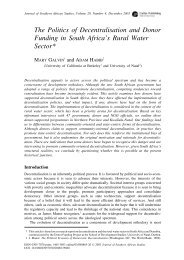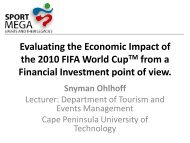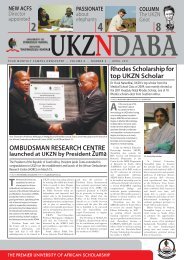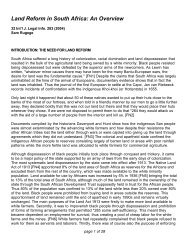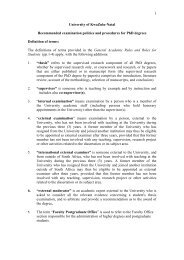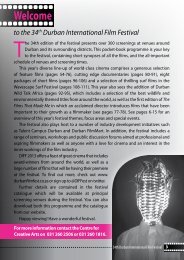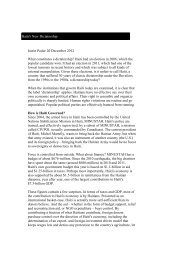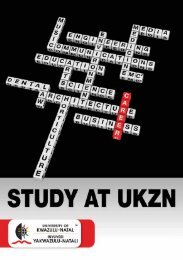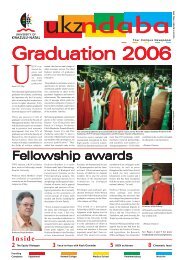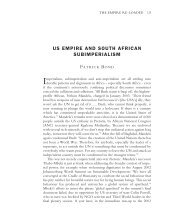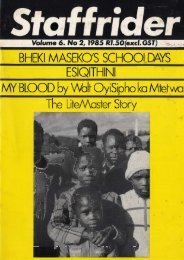Times Higher Education ranks UKZN in the Top 400 Page 3
Times Higher Education ranks UKZN in the Top 400 Page 3
Times Higher Education ranks UKZN in the Top 400 Page 3
Create successful ePaper yourself
Turn your PDF publications into a flip-book with our unique Google optimized e-Paper software.
6YOUR MONTHLY CAMPUS NEWSPAPER • VOLUME 9 • NUMBER 9 • SEPTEMBER 2012The first critical m<strong>in</strong>utes, hours when HIV or TB <strong>in</strong>vade <strong>the</strong> body’s immune system is <strong>the</strong> focus of a new chapter ofresearch. LIZ CLARKE spoke to a young scientist who is beg<strong>in</strong>n<strong>in</strong>g this journey of <strong>in</strong>vestigation <strong>in</strong> Durban.Big guns out <strong>in</strong> <strong>the</strong> fightaga<strong>in</strong>st TB and HIV/AIDSLASDAIR Leslie certa<strong>in</strong>lycould be helpful for diagnostics.doesn’t fit <strong>the</strong> prototypecannot reach.A three dimensional model ofAFACT FILEdescription of <strong>the</strong> studiousIn part this is responsible for human tissue that would have beenand bespectacled boff<strong>in</strong> scientisttucked beh<strong>in</strong>d a row of petri dishes.A quirky modernist, with asense of fun, he will be part of acl<strong>in</strong>ical and diagnostic<strong>in</strong>vestigative team tak<strong>in</strong>g up aresearch post at <strong>the</strong> newlyestablished KwaZulu-NatalResearch Institute for TB and HIV(K-RITH).Career change, marriage andtwo young kids stand between himand <strong>the</strong> last time he lived <strong>in</strong> Africabut he makes no bones about <strong>the</strong>fact that he still has a passion for<strong>the</strong> stark and expansive landscapeshe fell <strong>in</strong> love with some years agoas a volunteer teacher.‘When I returned to <strong>the</strong> UK <strong>in</strong>2002 with my now wife, Georgie,part of me was left beh<strong>in</strong>d <strong>in</strong>Malawi where I had met so manyunforgettable people. I just hopedthat one day I would have a chanceto come back to Africa and dosometh<strong>in</strong>g useful.’But to get back and ‘dosometh<strong>in</strong>g useful’ <strong>in</strong>volved quite anunorthodox passage, particularlyas his knowledge emanated from amasters’ degree <strong>in</strong> agriculture!Born and brought up <strong>in</strong> <strong>the</strong>English county of Surrey, hebelieves that exploration,<strong>in</strong>vestigation and new challengesare part and parcel of his life.‘So when I returned to Englandonly to f<strong>in</strong>d that <strong>the</strong>re were noopen<strong>in</strong>gs for me as a scientist <strong>in</strong> <strong>the</strong>agriculture sector, I knew it wastime to change direction.’He came across anadvertisement for a laboratoryassistant based at OxfordUniversity study<strong>in</strong>g <strong>the</strong> immuneresponse to HIV <strong>in</strong>fection.‘It immediately caught my eye.The devastat<strong>in</strong>g effects had beenpa<strong>in</strong>fully apparent <strong>in</strong> Malawi,where high rates of HIV <strong>in</strong>fectionwere compounded by extremepoverty and a lack of health care<strong>in</strong>frastructure. I lost several friendsto <strong>the</strong> disease dur<strong>in</strong>g my time <strong>the</strong>re.Dendritic cells are among <strong>the</strong> firstimmune cells to encounter <strong>the</strong>virus, and are essential <strong>in</strong> driv<strong>in</strong>gan effective immune response.However, it is becom<strong>in</strong>g<strong>in</strong>creas<strong>in</strong>gly apparent that HIV isable to <strong>in</strong>terfere with this<strong>in</strong>teraction <strong>in</strong> ways that impair<strong>in</strong>itial immune response andallow <strong>the</strong> pathogens to hide <strong>in</strong>reservoirs that medicationAlasdair Leslie.At least, I assumed that’s what itwas. It wasn’t really talked about.’Six months after successfullyapply<strong>in</strong>g for <strong>the</strong> job, Leslie wasoffered a position as a PhD studentexplor<strong>in</strong>g <strong>the</strong> relationship betweenHIV and <strong>the</strong> body’s host cells, try<strong>in</strong>gto understand how HIV manages toavoid be<strong>in</strong>g wiped out by ourimmune systems.Recently he extended thosestudies to <strong>in</strong>clude <strong>the</strong> tuberculosiscaus<strong>in</strong>gbacteria Mycobacteriumtuberculosis (mTB) – a journey that<strong>the</strong> rapid early viral spread anddamage to <strong>the</strong> immune systemthat is <strong>the</strong> hallmark of this deadlydisease.The work at K-RITH will bedone <strong>in</strong> collaboration with DrMattias Svensson from <strong>the</strong>Karol<strong>in</strong>ska Institute <strong>in</strong> Swedenand Dr Ben Owens <strong>in</strong> Oxford, whohave developed <strong>the</strong> lung and gutmucosal models respectively.has now brought him to Durbanwith his wife and two young sons,Samora and Julius.‘Gett<strong>in</strong>g to grips with both <strong>the</strong>sediseases, not know<strong>in</strong>g exactly whatwe will f<strong>in</strong>d, or what <strong>the</strong> impact willbe on halt<strong>in</strong>g <strong>the</strong>se pandemics –that is <strong>the</strong> overwhelm<strong>in</strong>gchallenge.’With <strong>the</strong> support of a five-yearresearch grant from K-RITH,Leslie’s area of <strong>in</strong>terest, toge<strong>the</strong>rwith a team of researchers, will beto try and unbutton <strong>the</strong> mysteriessurround<strong>in</strong>g <strong>the</strong> responses made by<strong>the</strong> immune system cells at <strong>the</strong>moment HIV and TB pathogensenter <strong>the</strong> body.It’s pretty clear that pathogenslike HIV and mTB have evolvedways of <strong>in</strong>terfer<strong>in</strong>g with this <strong>in</strong>itialsignal<strong>in</strong>g, and that allows <strong>the</strong>m tosurvive. But we need to know awhole lot more.” One of <strong>the</strong> keys tounderstand<strong>in</strong>g <strong>the</strong> <strong>in</strong>itial diseasebattleground are <strong>the</strong> Dendriticcells, expla<strong>in</strong>s Leslie.‘They are <strong>in</strong> <strong>the</strong> front l<strong>in</strong>e of fire,responsible for recognis<strong>in</strong>g andsignal<strong>in</strong>g <strong>the</strong> arrival of both HIVand TB. Once we have built up aclearer picture of <strong>the</strong> key prote<strong>in</strong>s<strong>in</strong>volved <strong>in</strong> this recognition processand p<strong>in</strong> down some of <strong>the</strong> ways <strong>in</strong>which <strong>the</strong> <strong>in</strong>vad<strong>in</strong>g pathogens areable to modify this <strong>in</strong>teraction to<strong>the</strong>ir benefit, we should have someuseful data.’Knowledge ga<strong>in</strong>ed, he says,could reveal new targets forpotential drugs, vacc<strong>in</strong>es, orbiological markers of disease thata far-fetched snippet of sciencefiction a few years ago, will soonplay an important role <strong>in</strong> thisunfold<strong>in</strong>g medical story.Expla<strong>in</strong><strong>in</strong>g <strong>the</strong> process, Lesliesays that thanks to recent advances,it is possible to culture varioustypes of human lung or gut cells <strong>in</strong>a lab dish and “coax <strong>the</strong>m toorganise <strong>the</strong>mselves <strong>in</strong>to structuresthat are virtually <strong>in</strong>dist<strong>in</strong>guishablefrom <strong>the</strong> natural tissues.”What does this mean?‘It means that by <strong>in</strong>troduc<strong>in</strong>gcells from <strong>in</strong>fected patients <strong>in</strong>to <strong>the</strong>tissue models we can observe howHIV severely damages <strong>the</strong> gutmucosa, a process that has beenvery difficult to study <strong>in</strong> humans.‘We’ve always had to rely on animaltissue or s<strong>in</strong>gle cells grown <strong>in</strong> alaboratory, which behave verydifferently.’Leslie also plans to use thistechnique to <strong>in</strong>vestigate <strong>the</strong>formation and ma<strong>in</strong>tenance of TBgranulomas. These are <strong>the</strong> clustersof <strong>in</strong>fected and un<strong>in</strong>fected cells thatform <strong>in</strong> <strong>the</strong> lungs of patients as<strong>the</strong>ir immune systems attempt towall off <strong>the</strong> TB pathogen.‘Granulomas are a hallmark ofTB <strong>in</strong>fection, yet whe<strong>the</strong>r <strong>the</strong>irformation favours <strong>the</strong> host or <strong>the</strong>pathogen, we don’t really know.’The techniques, he says, don’trequire extremely high-techequipment.‘You need <strong>the</strong> expertise – we’vegot that – and you need access topatient samples – which we have <strong>in</strong>South Africa, and you need anenvironment that is 100 percentfocused on driv<strong>in</strong>g <strong>the</strong> scienceforward – and that is what K-RITHis. It’s exactly <strong>the</strong> k<strong>in</strong>d of researchthat should be happen<strong>in</strong>g <strong>in</strong> thispart of <strong>the</strong> world where <strong>the</strong> effectsof TB and HIV are so keenly felt.”‘Always <strong>the</strong> ultimate aim is toprovide data that will be useful <strong>in</strong><strong>the</strong> fight aga<strong>in</strong>st <strong>the</strong>se terriblediseases. I hope to be part of that<strong>in</strong>credible journey’.Healthy CornerTHIS is <strong>the</strong> first <strong>in</strong> a series ofcolumns on health issues to assistreaders to take proper care of <strong>the</strong>irbodies. September was NationalHeart Awareness Month so <strong>in</strong> this<strong>in</strong>augural column <strong>the</strong> focus is onthat most vital organ: The Heart.Heart diseaseHeart disease refers to severaltypes of heart conditions <strong>in</strong>clud<strong>in</strong>gcoronary artery disease, ang<strong>in</strong>a,heart failure and arrhythmias.CausesSome medical conditions as wellas lifestyle factors can put people athigher risk of gett<strong>in</strong>g heart disease.The most important of <strong>the</strong>se arehigh blood pressure, high bloodcholesterol, cigarette smok<strong>in</strong>g,diabetes and obesity.Signs and SymptomsThe five major signs thatsomeone is hav<strong>in</strong>g a heart attackare:• Pa<strong>in</strong> or discomfort <strong>in</strong> <strong>the</strong> jaw, neckor back• Feel<strong>in</strong>g weak, light-headed or fa<strong>in</strong>t• Chest pa<strong>in</strong> or discomfort• Pa<strong>in</strong> or discomfort <strong>in</strong> arms orshoulder• Shortness of breath.If you th<strong>in</strong>k that someone ishav<strong>in</strong>g a heart attack, you shouldcall emergency servicesimmediately.PreventionYou can prevent heart disease byliv<strong>in</strong>g a healthy lifestyle:• Eat a healthy diet. Be sure to eatplenty of fruits and vegetables.Eat<strong>in</strong>g foods low <strong>in</strong> saturated fatand cholesterol and high <strong>in</strong> fibrecan help prevent high bloodcholesterol. Limit<strong>in</strong>g salt of sodium<strong>in</strong> your diet can lower your bloodpressure;• Ma<strong>in</strong>ta<strong>in</strong> a healthy weight. Be<strong>in</strong>goverweight or obese can <strong>in</strong>creaseyour risk for heart disease;• Exercise regularly. Physical activitycan help you ma<strong>in</strong>ta<strong>in</strong> a healthyweight and lower cholesterol andblood pressure;• Do not smoke. Smok<strong>in</strong>g greatly<strong>in</strong>creases your risk for heart disease;• Limit alcohol use. Avoid dr<strong>in</strong>k<strong>in</strong>gtoo much alcohol. It causes highblood pressure.TreatmentThe treatment for heart diseasedepends on <strong>the</strong> k<strong>in</strong>d of heart diseaseyou have and how serious it is. Yourhealthcare provider will be able toassist you. – www.doh.co.zaLUNGA MEMELATHERE is a grow<strong>in</strong>g need for SouthAfrican researchers <strong>in</strong> <strong>the</strong> field offorensic anatomy, says <strong>UKZN</strong>alumnus and <strong>in</strong>ternationallyacclaimed Specialist ForensicPathologist, Dr Shereen Akoojee.Akoojee, hosted by <strong>the</strong> School ofLaboratory Medic<strong>in</strong>e and MedicalSciences, was speak<strong>in</strong>g at a journalclub meet<strong>in</strong>g of <strong>the</strong> Discipl<strong>in</strong>e ofCl<strong>in</strong>ical Anatomy (DOCA).She outl<strong>in</strong>ed foetus and young<strong>in</strong>fant medico-legal cases whichwere often related to illegalterm<strong>in</strong>ation of pregnancy,abandoned babies and baby <strong>the</strong>ft <strong>in</strong><strong>the</strong> country.Currently attached to <strong>the</strong>country’s Independent MedicoLegal Unit (IMLU) – a Street Lawproject established to facilitateaccess to justice through <strong>the</strong>development of a democraticforensic service ethos <strong>in</strong> SouthAfrica - Akoojee serves as a forensicconsultant, tra<strong>in</strong>er and researcher.Akoojee said <strong>the</strong> medicalapplication of forensic anatomyForensic anatomy research <strong>in</strong> South AfricaDr Shereen Akoojee (centre) was warmly received by <strong>the</strong> Discipl<strong>in</strong>e ofCl<strong>in</strong>ical Anatomy’s Professor Mohamed Haffajee and Dr Okpara Azu.was relevant <strong>in</strong> understand<strong>in</strong>gcongenital and geneticabnormalities. She said forensicanatomy positioned <strong>the</strong> medicolegalfraternity as experts <strong>in</strong>identify<strong>in</strong>g gestational ag<strong>in</strong>g - <strong>the</strong>age of a foetus or new-born <strong>in</strong>fant.Akoojee’s keen and specific<strong>in</strong>terest <strong>in</strong> forensic anatomy andphysical anthropology has seen heractively <strong>in</strong>volved <strong>in</strong> <strong>the</strong> facilitationand development of tra<strong>in</strong><strong>in</strong>g andskills development programmes <strong>in</strong>Cl<strong>in</strong>ical Forensic Medic<strong>in</strong>e andForensic Pathology for legalpractitioners and health careprofessionals <strong>in</strong>volved <strong>in</strong> <strong>the</strong>adm<strong>in</strong>istration of justice.Akoojee was previously <strong>the</strong>Chief Specialist for ForensicServices and Bioethics <strong>in</strong> <strong>the</strong>KwaZulu-Natal Department ofHealth as well as <strong>the</strong> Inspector ofAnatomy for <strong>the</strong> prov<strong>in</strong>ce.The purpose of Akoojee’spresentation was to help identifypossible studies and stimulatefur<strong>the</strong>r discussion that wouldgenerate research opportunitiesand topics <strong>in</strong> forensic anatomy. It isenvisaged that such an outcomewould assist <strong>in</strong> establish<strong>in</strong>gstandards that are relevant andapplicable <strong>in</strong> <strong>the</strong> South Africancontext. Participants showedkeenness to form a forensicanatomy research <strong>in</strong>terest group.Akoojee said prospective studiescould establish and verify exist<strong>in</strong>gdata <strong>in</strong> South Africa, compare localdata <strong>in</strong> respect of <strong>the</strong> variousfactors used to establish <strong>the</strong>gestational age of a foetus, andresearchers could conductpopulation specific studies andexplore ethical issues <strong>in</strong> <strong>the</strong> SouthAfrican context.The journal club also listened toDr Edw<strong>in</strong> Naidu and Dr Adey<strong>in</strong>kaAlabi, both Masters and Doctoralcandidates respectively, whopresented stimulat<strong>in</strong>g researchwhich is pend<strong>in</strong>g.Dr Okpara Azu, Senior Lecturer<strong>in</strong> <strong>the</strong> Discipl<strong>in</strong>e said <strong>the</strong>y wouldexpand <strong>the</strong>ir research, teach<strong>in</strong>gand learn<strong>in</strong>g. ‘We <strong>in</strong>tend to achievethis by <strong>in</strong>vit<strong>in</strong>g more esteemed<strong>in</strong>dividuals, companies and<strong>in</strong>stitutions to come <strong>in</strong> and sharenew ideas/developments fromaround <strong>the</strong> world.’



